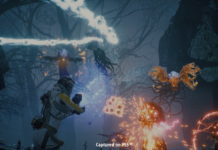This generation, game developers
love the idea of turning everything into an open-world adventure. But while the
days of linear action games are quickly slipping away, racing games tend to
follow a predetermined path. Even when venturing into open-world territory, a
racer must have some kind of environmental barrier, directional arrows, or an
easy-to-read GPS to keep players from getting lost.
That’s the situation of FUEL, a new
racing game from Asobo (the developer) and Codemasters (the publisher of the
unforgettable GRID and DiRT). It takes the open-world route with a slight veer
in the direction of MX vs. ATV Untamed. Players are dropped into FUEL’s gigantic
universe via helicopter. Each vehicle is attached to a helicopter with long
cables, and though this part is only a video, it’s hard not to imagine what it’d
feel like to actually be sitting in a vehicle as it’s carried – and then dropped
down – to a rugged and highly remote location.
With more than a few thousand square
feet of land enveloping each race, FUEL keeps players grounded with a clear
arrow system. You can turn it off if you’re too proud to ask for directions, but
believe me: this is not a game where you’ll want to carry around any pride. You
may, however, want to look into your previous driving experiences, virtual or
otherwise, as there are trucks, bikes, buggies, ATVs and bonus vehicles to
control in this game. Hence the similarities between FUEL and MX vs. ATV – with
so many rugged vehicles and several large-scale environments, the comparisons
were inevitable.
Once the race begins, you’ll
instantly take notice of the organic backdrops and Hollywood-inspired lighting.
Nighttime, for example, is more than a darkened version of the same stage: when
the sun goes down, the game is tinted with hues of black and dark blue, giving
FUEL a unique appearance that’s reminiscent of the artificial light seen in
movies. On the other side, daytime lighting comes in two forms: typical gaming
(if you’ve played other racing games, you already know this look) and a more
stylized sundown where orange and yellow hues are used to drench the screen in a
unique bit of color artistry. Plus, the frame rate stays consistent when the
action intensifies – even if the sun is blinding your eyes.
Such beauty, while impressive to be
certain, might seem irrelevant after making your first driving mistake. Mistakes
are inevitable; you’re going to crash into trees, skid off cliffs and slide into
water that’s much too deep to drive through. That’s the whole point of an
off-road racer.
Mid-race load screens, however,
should never be part of the experience. But that’s exactly what you get, as FUEL
doesn’t like the idea of crashing. Rather than give the player a display of
polygon goodness with every accident, the game cuts to a black screen and a FUEL
logo, pauses for a few seconds to re-load a game that should already be fully
loaded (pre-race load times aren’t quick), and comes right back to the game.
Your vehicle, with its paint untouched and the body un-crumpled, returns to the
track as if nothing happened. It’s pointed in the right direction, at least, and
you’ll notice that a few (possibly all) of your opponents have left you in the
dust. But visually there are no signs of the crash. Visually, it’s like the game
didn’t register its occurrence at all.
Crashing aside, there isn’t anything
particularly wrong with any of the vehicles. Bigger automobiles (such as trucks)
offer a bigger, heavier feel, while the smaller vehicles (such as ATVs) are
lighter and looser as expected. Slippery terrain is occasionally problematic but
it’s nothing gamers haven’t faced before, and is hardly something to complain
about in an off-road racer. If your tires could hug grass, dirt and water with
ease, you might as well be playing an on-road racer.
But while the vehicles are perfectly
acceptable in their controls and their design, the gameplay speed is an
unexpected drawback. With a steady frame rate, impressive outdoor backgrounds
and other visual treats, you wouldn’t think that speed would become an issue.
Isn’t every game, even the bad ones, achieving a
better sensation of speed?
Apparently not because, at top
speed, FUEL barely moves. The simplest way to describe its speedy sensations are
to compare them to the 50cc competitions in Mario Kart (a race type most people
avoid because it is the slowest, most mundane speed limit offered). You could
reason that a truck in FUEL, no matter how quick, should be slower than a
motorcycle. FUEL makes no such distinction, choosing instead to spread its
molasses pacing across every vehicle.
Which is not only disappointing,
it’s truthfully a shame. What we have here isn’t a game that’s filled with bugs
or serious, unfixable mechanical problems that make it unplayable. Nope – it’s just
slow; too slow to be fun. And that’s a shame because, if it had been a faster
and more aggressive racing game, players would have walked away excited and
eager for more. Now, they’ll probably just walk away.
|
|
Gameplay: 5.9
An open-world racing game with lots of vehicles and TONS of wide-open space.
But that’s all there is – vehicles and space.
Graphics: 8.0
Aside from the abrupt load screen that appears every time you crash, FUEL is
one good-looking game. The high-end textures, deep draw-distance and unique
lighting are just a few of the standout elements. Even tornados are featured!
But since the effects are pure arcade, if you’re going for sheer graphical
realism, FUEL isn’t at the head of the class.
Sound: 5.0
Music and sound effects that are so unmemorable I can barely remember what
they were like.
Difficulty: Easy/Medium
Cheap AI (opponents who magically lead the pack of a race) is about the only
thing you’ll have to worry about.
Concept: 5.0
An open-world off-road racer with a multitude of vehicles and miles of
driving space. Yeah, we’ve seen this before.
Multiplayer: 5.0
Up to 16 can race online, but Fuel is much too slow to be a racing game
you’ll want to play with others.
Overall: 5.9
A cool-looking racing game that ultimately crumbles under the weight of its
own slow pace.












